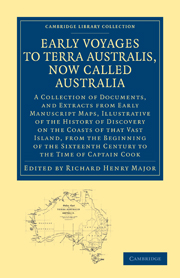 Early Voyages to Terra Australis, Now Called Australia
Early Voyages to Terra Australis, Now Called Australia Book contents
- Frontmatter
- Contents
- INSTRUCTIONS TO THE BINDER
- INTRODUCTION
- A MEMORIAL ADDRESSED TO HIS CATHOLIC MAJESTY PHILIP THE THIRD, KING OF SPAIN
- RELATION OF LUIS VAEZ DE TORRES
- EXTRACT FROM THE BOOK OF DISPATCHES FROM BATAVIA
- THE VOYAGE AND SHIPWRECK OF CAPTAIN FRANCIS PELSART
- VOYAGE OF GERRIT THOMASZ POOL TO THE SOUTH LAND
- ACCOUNT OF THE WRECK OF THE SHIP “DE VERGULDE DRAECK”
- DESCRIPTION OF THE WEST COAST OF THE SOUTH LAND
- EXTRACT TRANSLATED FROM BURGOMASTER WITSEN'S
- ACCOUNT OF THE OBSERVATIONS OF CAPTAIN WILLIAM DAMPIER
- EXTRACT FROM SLOAN MS., 3236
- SOME PARTICULARS RELATING TO THE VOYAGE OF WILLEM DE VLAMINGH
- EXTRACT FROM THE JOURNAL OF A VOYAGE MADE TO THE UNEXPLORED SOUTH LAND
- ACCOUNT OF THE OBSERVATIONS OF CAPTAIN WILLIAM DAMPIER
- A WRITTEN DETAIL OF THE DISCOVERIES AND NOTICEABLE OCCURRENCES
- THE HOUTMAN'S ABROLHOS
- INDEX
- Outline Chart of TERRA AUSTRALIS OF AUSTRALIA
- Plate section
VOYAGE OF GERRIT THOMASZ POOL TO THE SOUTH LAND
Published online by Cambridge University Press: 05 February 2013
- Frontmatter
- Contents
- INSTRUCTIONS TO THE BINDER
- INTRODUCTION
- A MEMORIAL ADDRESSED TO HIS CATHOLIC MAJESTY PHILIP THE THIRD, KING OF SPAIN
- RELATION OF LUIS VAEZ DE TORRES
- EXTRACT FROM THE BOOK OF DISPATCHES FROM BATAVIA
- THE VOYAGE AND SHIPWRECK OF CAPTAIN FRANCIS PELSART
- VOYAGE OF GERRIT THOMASZ POOL TO THE SOUTH LAND
- ACCOUNT OF THE WRECK OF THE SHIP “DE VERGULDE DRAECK”
- DESCRIPTION OF THE WEST COAST OF THE SOUTH LAND
- EXTRACT TRANSLATED FROM BURGOMASTER WITSEN'S
- ACCOUNT OF THE OBSERVATIONS OF CAPTAIN WILLIAM DAMPIER
- EXTRACT FROM SLOAN MS., 3236
- SOME PARTICULARS RELATING TO THE VOYAGE OF WILLEM DE VLAMINGH
- EXTRACT FROM THE JOURNAL OF A VOYAGE MADE TO THE UNEXPLORED SOUTH LAND
- ACCOUNT OF THE OBSERVATIONS OF CAPTAIN WILLIAM DAMPIER
- A WRITTEN DETAIL OF THE DISCOVERIES AND NOTICEABLE OCCURRENCES
- THE HOUTMAN'S ABROLHOS
- INDEX
- Outline Chart of TERRA AUSTRALIS OF AUSTRALIA
- Plate section
Summary
On the 26th of March, 1636, there arrived two shallops, the Amsterdam and the Weasel, sent from Amboina, with orders to Governor Acoley at Banda, to give to the commander of these ships, Gerard Thomasz Pool, such information concerning the South Land as might be necessary for him to perform a voyage thither, under the orders of the honourable Company.
After he had received the desired instructions, and had been furnished with sufficient provisions and other necessaries, he sailed with those vessels on the 17th of April.
On the 30th of June following both these vessels returned, and informed the governor that, having reached the Flat Point in about 4½ degrees of south latitude on the 18th of April, they had determined to send some of their people on shore to take a view of the country. The Commander Pool, desirous to see everything himself, resolved to be of the party, and took with him his steward, Andries Schiller, a native of Nuremberg. They were scarcely landed, when a large body of wild Southlanders, who at first appeared friendly, but acted afterwards in a hostile manner, surrounded them, in so much that it was not in their power to escape. The Commander Pool perceiving the danger greater than he at first expected, was still in hopes to escape; but he found himself attacked one of the first, and received a blow with a hazegay, which immediately brought him to the ground.
- Type
- Chapter
- Information
- Early Voyages to Terra Australis, Now Called AustraliaA Collection of Documents, and Extracts from Early Manuscript Maps, Illustrative of the History of Discovery on the Coasts of that Vast Island, from the Beginning of the Sixteenth Century, pp. 75 - 76Publisher: Cambridge University PressPrint publication year: 2010First published in: 1859


